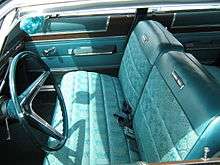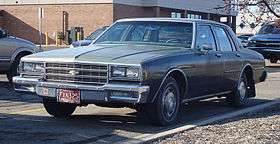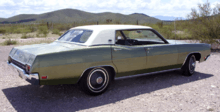Full-size car


Full-size car is a marketing term used in North America for an automobile larger than a mid-size car. Traditional U.S. full-size passenger cars were designed to be comfortable for six occupants and their luggage for long-distance driving. The United States Environmental Protection Agency (EPA) currently uses the term large car to denote full-size cars based on their combined interior passenger and luggage volume.
Definition
.jpg)

The American Heritage Dictionary describes "the standard or normal size" as a full-size car.[1]
The traditional full-size passenger cars that were built by the U.S. automakers (General Motors, Ford, Chrysler, and American Motors) up to the 1970s "can carry six occupants plus vast amounts of luggage over long distances in great comfort, with more than adequate performance, and will give reasonable gas mileage under such conditions".[2]
Full-size cars were also denoted for their length, nearing 4,953 mm (195 in) in basic low-priced, family sedans. The luxury models often tended to reach 5,350 mm (211 in). Previously, a wheelbase greater than 2,794 mm (110 in) was the criterion for full-size. The term first appeared in the early 1960s to distinguish what also became known as "standard"-size cars from the new compact and intermediate models then being introduced. The U.S. EPA defines "large" size as 120 cu ft (3.4 m3) or more of combined passenger and cargo interior volume in sedans and 160 cu ft (4.5 m3) or more in station wagons.[3] A majority of U.S. automakers manufactured full size automobiles were constructed using a body-on-frame platform (with the exception of the Chrysler C platform and AMC's Ambassador). This design was phased out in 2011 when vehicles using the Ford Panther platform ended production.
Use of the full-size term in North America became popular after the introduction of compact-sized cars by the U.S. "Detroit Big Three" for the 1960 model year, and then a few years later the introduction of what became known as mid-size cars. While length and wheelbase varied (increasing over time) being considered full-size required a width as close as practical to the 80 in (2,032 mm) width limit over which the federal government required vehicles to have clearance lights.[4] The term was most correctly applied to cars close to the width limit carrying nameplates of the "Low Priced Three", Chevrolet, Ford, and Plymouth.[5] Into the 1960s, this term was applied to the first level of cars targeted at "working people who wanted a roomy, reliable, economical car, with perhaps a little style thrown in."[6]
Manufacturers hoped their slightly more expensive brands such as Pontiac, Mercury, and Dodge, would be perceived by the public as more desirable than a full-size car even in situations where they were not any larger. However, while the difference between a full-size car, a basic large Chevrolet, Ford, or Plymouth, and a luxury car such as Cadillac, Lincoln, or Imperial, was clear, both manufacturers and consumers had difficulty classifying those in between, such as large Pontiacs, Mercurys, or Dodges. Manufacturers contributed to the lack of distinction by marketing models of their premium brands into the lower price ranges with what had previously been considered medium-priced brands.
For 1977, General Motors downsized its full-size (and higher priced) cars, with overall width cut from approximately 80 in (2,032 mm) to the mid-70 inch range. Chevrolet, Pontiac, and the less expensive Oldsmobile and Buick models had a 116-inch wheelbase. More expensive Oldsmobile and Buick models, plus the Cadillac had a 119 in (3,023 mm) wheelbase, but no more width. The cars were well received by the press and the customers; full sized Chevrolets that had lost the top of the sales chart in 1976 for the intermediate Oldsmobile Cutlass regained the top spot for 1977. Ford and Chrysler downsized for 1979, the latter even building its Chrysler R platform, which was comparable in size to the new platforms designed by GM and Ford. By this time, a huge increase in gasoline prices had made it difficult to sell any large cars, downsized or not. Chrysler had the huge misfortune of introducing two consecutive new designs of its largest cars, in 1974 and 1979, during times when gasoline prices suddenly increased.
The EPA interior volumes for passenger and cargo for the most part resulted in mid-size, full-size, and luxury cars common in the mid-1970s all being classified as large cars. The 1980s Chrysler M platform, classified as large cars at the time, were derived from the Dodge Aspen/Plymouth Volare (F-body) platform, originally marketed as "large compacts".
While many modern cars are referred to as full-size, they do not qualify for the term as used in the 1960s and 1970s. Consumer acceptance of large SUVs approaching 80 inches in width shows interest remains in vehicles capable of three-across seating with reasonable comfort, a strong point of a true full-size car.
Police cars in the United States are almost always full-size cars, such as the Ford Crown Victoria. This is usually due to the amount of interior space for an arrestee as well as trunk volume for computer and electrical equipment. Interior space and trunk volume also make such vehicles popular for taxi use. Since the discontinuation of the Ford Crown Victoria Police Interceptor, the replacements have been variations of the Ford Taurus, Dodge Charger, and Chevrolet Impala.
Decline, renaissance, and further decline


The sales of full-size vehicles in the United States declined after the early 1970s fuel crisis.[7] By that time, full-size cars had grown to wheelbases of 121–127 inches (3.1–3.2 m) and overall lengths of around 225 in (5,715 mm). In the 1970s, due to the fuel crisis and the resulting rise in fuel costs, many people traded in their full-size cars for smaller models such as the Chevrolet Nova, Ford Maverick, and Plymouth Valiant, also it was during this time small Japanese cars such as the Toyota Corolla and Honda Civic gained popularity. The perennial US small car manufacturer, American Motors, discontinued its full-size 122-inch (3,099 mm) wheelbase AMC Ambassador in 1974 to focus development on its more compact models.[8][9] Starting in the late-1970s, the other American automakers began selling full-size cars with smaller exterior dimensions and smaller, more fuel efficient engines. That, combined with gas being cheap once again in the late-1980s, full-size cars regained popularity.
Chrysler discontinued its full-size cars (Dodge St. Regis, Chrysler Newport and New Yorker, Plymouth Gran Fury) in 1981.[10] With full-size cars only 8.3 percent of sales in 1994 compared to 65 percent in 1960[11] General Motors discontinued some of its full-size cars (Chevrolet Impala SS/Chevrolet Caprice, Buick Roadmaster, Oldsmobile Ninety-Eight, and Cadillac Fleetwood) in 1996. Buick still had Park Avenue and LeSabre, Oldsmobile had the Regency and the Eighty-Eight, and Cadillac still had the DeVille. Oldsmobile discontinued full-size cars in 1999, and Buick and Cadillac introduced the Lucerne and DTS, respectively, in 2006. The 2011 model year was the final year of production of the Ford Panther platform (the Ford Crown Victoria/Ford Police Interceptor, Mercury Grand Marquis, and Lincoln Town Car), as well as the Lucerne.
During the 1980s and 1990s, full-size cars lost ground to other vehicle types as family vehicles. Initially, full-size sedans and station wagons lost ground to vans, which offered additional seating and cargo capacity with lower fuel consumption. During the 1990s, full-size sedans and wagons lost further ground to mid-size and full-size SUVs, as they had similar towing capacity and a V8 engine started becoming an option in mid-size versions. In North America, full-size station wagons would vanish during the 1990s; Ford was the first to discontinue theirs after the 1991 model year, with GM following suit after 1996.
As fuel costs increase, more consumers select more efficient vehicles. These include automobiles such as compact and mid-size vehicles powered by smaller, more efficient engines. American-brand full-size sedans such as Buicks, and luxury full-size Cadillac DTS are still best-selling in the full-size segment. However, there is a serious attack on full-size by automakers to replace the size with price range. For example, a review by U.S. News & World Report, named "Best luxury large cars of 2008" included only one large car (Cadillac DTS) while the others are mid-size cars. This is mostly because, in Europe, full-size cars only exist as absolute luxury cars (F segment). In 2010, less than a half percent of the new cars sold in Germany fit into this category.[12] In other European countries, even the D- and E segments (making together the equivalent to U.S. mid-size cars) are not common.
By the mid-2010s, full-size cars began seeing a steep decline in sales in North America, with the Nissan Maxima being the only nonluxury full-size sedan to see a sales increase in 2016, in a year in which the model was completely redesigned.[13] This has led to speculation on Ford ending production of the Ford Taurus outside China (leaving the Lincoln Continental as its only full-size offering in the United States),[14]. This was confirmed in April, 2018, when Ford announced the sales of all Ford-branded passenger cars with the exception of the Mustang and non-hatch Focus models would end by 2022.[15] Reports surfaced that GM would discontinue six models to focus more on crossover production, four of them being the company's four full-size sedans including the Chevrolet Impala.[16] Hyundai confirmed that they would stop selling the Hyundai Azera in the United States after 2017, though part of this was related to the creation of Hyundai's Genesis lineup that cannibalized sales of the Azera after 2008;[17] its corporate sibling (via Kia Motors), the Kia Cadenza, remains available, as does the unrelated Kia K900. Fiat Chrysler Automobiles is also considering axing the Chrysler 300 after 2020, partially to reduce identical models sold in the same showrooms as Dodge, as well as the 300 having seen a steep decline in sales compared to the Dodge Charger.[18]
Outside North America
_G6E_Turbo_sedan_(2016-01-29)_01.jpg)
A "large family car", the equivalent of a full-size car class in Australian terms, is often denoted by width. Therefore, the Ford Falcon and Toyota Aurion are considered large cars in the Australian and New Zealand markets. These cars are sometimes referred to as "family cars" in Australia, and are typically 4,800 mm (189 in) or more in length.
In the United Kingdom and Ireland, the term is not used.
These are equivalent to American "midsize" cars.
See also
References
- ↑ "American Heritage Dictionary of the English Language" (Fifth ed.). Houghton Mifflin Harcourt. 2016. Retrieved 9 February 2018.
- ↑ Norbye, Jan; Dunne, Jim (February 1974). "Is there still a place for FULL-SIZE cars?". Popular Science. 204 (2): 24, 26, 30, 34, and 35. Retrieved 6 January 2014.
- ↑ "Frequently Asked Questions: How are vehicle size classes defined?". fueleconomy.gov (U.S. Department of Energy). Retrieved 7 June 2016. Click "How are vehicle size classes defined?"
- ↑ "Part 393 - Lamps and Reflective devices". Federal Motor Carrier Safety Administration. Retrieved 9 February 2018.
- ↑ "Vintage Reviews: Motor Trend's 1957 New Car Issue – Road Testing The Low Priced Three". curbsideclassic.com. 16 September 2016. Retrieved 9 February 2018.
- ↑ Cobb, James G. (15 June 1997). "The Return of Detroit's 'Low Priced Three'". The New York Times. Retrieved 9 February 2018.
- ↑ Peterson, Willis L. (1989). Principles of Economics: Micro (Seventh ed.). Irwin. p. 11. ISBN 9780256067965. Retrieved 13 July 2017.
The turnabout in the downward trend of energy prices that occurred during the mid-1970s caused large changes in the size and fuel efficiency of cars demanded by U.S. consumers and in turn changed the products produced by U.S. car makers.
- ↑ Cranswick, Marc (2001). "AMC's Final Full-Size - Ambassador - 1967-74". Cars of American Motors: An Illustrated History. McFarland. pp. 167–176. ISBN 978-0-7864-4672-8. Retrieved 13 July 2017.
- ↑ "American Motors: Less models but evolutionary changes". Automotive Industries. Chilton. 151: 33. 1974. Retrieved 13 July 2017.
In a rather stunning move, AMC is cutting its number of models from 13 in 1974 to eight in 1975. Partly because the company is able to sell practically anything it builds, three cars — Ambassador, Javelin and AMX — have been discontinued.
- ↑ Witzenburg, Gary (October 1981). "Driving the 1982 Chryslers". Popular Mechanics. 156 (4): 90. Retrieved 28 February 2017.
With all its full-size cars discontinued, those gas-guzzler names are transferred to the remaining 112.7-in wheelbase, rear-drive, intermediate, four-door sedans.
- ↑ Jedlicka, Dan (1 May 1995). "American Tradition is Still Around - The Big Car lives". Chicago Sun-Times. Retrieved 9 February 2018.
- ↑ "Pkw-Neuzulassungen im Jahr 2010" (in German). Heise.de. 7 January 2011. Retrieved 6 January 2014.
- ↑ Muller, David (6 January 2017). "In the Biggest Year Ever for Auto Sales, Big Sedans Sank". Car and Driver. Retrieved 9 February 2018.
- ↑ "Ford gets earnings boost, may drop Taurus and C-Max". autoblog.com. Reuters. 6 July 2017. Retrieved 9 February 2018.
- ↑ Bunkley, Nick (April 25, 2018). "Ford to stop selling sedans in North America in face of unstoppable crossover onslaught". AutoWeek.com.
- ↑ Snavely, Brent (26 July 2016). "GM may discontinue six sedans from Cadillac, Buick, Chevy". The Chicago Tribune. Retrieved 9 February 2018.
- ↑ Cain, Timothy (6 July 2017). "Hyundai Azera to be Discontinued After 2017". AutoGuide.com. Retrieved 9 February 2018.
- ↑ Vellequette, Larry P. (7 November 2016). "FCA's-big-cars-extended-to-2020". Automotive News. Retrieved 9 February 2018.
